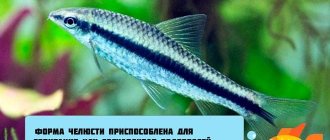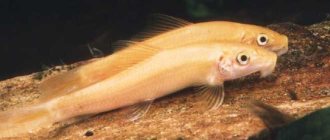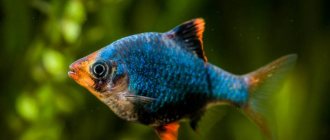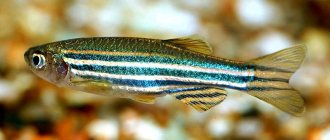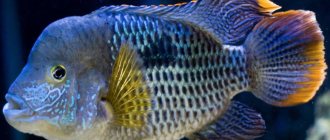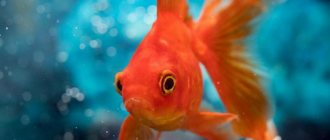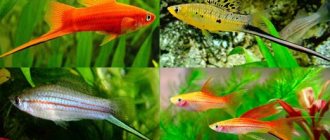Catfish clean the walls of the aquarium and eat the remaining food that falls to the bottom. That is why every aquarist has such an unpretentious and useful creature. Ancistrus or sucker belongs to the chain catfish. What is good about aquarium fish and why do aquarists love it so much?
The homeland of this bottom-dwelling fish is the northern and central regions of South America. There they inhabit rivers, swamps, and mountain streams.
Photo: Ancistrus dark
Description and general information
Catfish girinocheilus or, in other words, Chinese algae eater is an ornamental aquarium fish from the carp family, a favorite of many aquarists. A medium-sized fish, bright in color, it gained its popularity due to its hard work, the most tireless and conscientious, clearing the home pond of excess algae.
In nature, it is found in bodies of water characterized by strong currents and a lot of algae and driftwood at the bottom, mainly in East Asia and China. The fish is native to Vietnam, Thailand, Laos, and Cambodia. Algae eaters can migrate, depending on the time of year they can be found in different places, even in flooded rice fields. In the east, this fish is allowed to be caught for sale. As a result, in some countries it is on the verge of extinction and is listed in the Red Book. Belongs to the carp family.
Keeping in an aquarium
The best option is an aquarium of 100 liters or more; if it is kept in a general aquarium, then the volume of water per individual should be at least 30 liters.
Plants are planted densely. Coarse sand or small pebbles are suitable as soil. Be sure to place driftwood in the aquarium, from which it receives the necessary substances.
Large stones, ceramic decorations, and grottoes are suitable for decoration. The latter will be especially appropriate if he lives in an aquarium with his own kind. The presence of many shelters will allow you to minimize conflicts and fights, which sometimes even end in the death of the weaker fish.
Water parameters
Temperature: 23 – 27° C pH: 6.0 – 8.0 Hardness: from 5 to 19° dGH
Active filtration with aeration and weekly changes of a third of the water are required.
Plants
Plant any plants you like in an aquarium with golden algae eaters. If there is a sufficient amount of plant food, the fish will not touch even plants with delicate leaves. Plant plants in large numbers to create natural hiding places for fish. Suitable for beginners:
- ferns;
- Anubias;
- cryptocorynes;
- mosses.
Experienced aquarists can plant more demanding plants:
- water lilies;
- lindernia;
- aciotis;
- ludwigia.
Priming
Fill the bottom with small pebbles and gravel or sandy soil.
Equipment
Equipment you will need:
- Filter. The device must create a flow of water. External filters provide high-quality filtration thanks to a variety of filter materials.
- Compressor. Responsible for supplying oxygen. Choose a powerful device. A lack of oxygen is indicated by the accumulation of aquarium inhabitants in the upper layers of water.
- Heater. The temperature should not fall below 20 degrees, otherwise golden algae eaters will become lethargic and susceptible to disease. When the room is constantly heated, heating is not required. You can cool water in the summer with canisters of frozen water.
Types of Gyrinocheilus
The most common species of aquarium representatives of Gyrinocheilus are golden specimens. Natural colors are rare. The species on sale are those that are bred on special farms, and not brought from natural bodies of water. Girinocheilus differ only in color; in character and conditions of detention, they are absolutely identical.
Ordinary
Gyrinocheilus is ordinary - the color of the body is from yellowish to olive in color with black dots on the sides, the edges of the scales are dark. The standard size of an aquarium fish is 10-12 cm.
Siamese
Girinocheilus siamese - the color of the body is yellowish-orange. Can easily be confused with the Siamese algae eater, but it has a black stripe along the body and the mouth has a different structure.
Gold and yellow
Gyrinocheilus golden - the color of the body is golden, sometimes there are dark spots on the sides. Another name for this fish is “chanterelle”.
The yellow algae eater has a more uniform color.
Gyrinocheilus common
Girinocheilus siamese
Yellow type
Albino
These representatives have a white body with a pinkish tint without any other markings. The main natural varieties of Gyrinocheilus look exactly like this.
Marble
Marbled Gyrinoheylus has a light brown color with dark spots. The scaly pattern is clearly visible. There are black dots on the translucent tail. Fish with this coloring are also found in nature. The color of the body resembles milk chocolate, and the dark spots are located so that they resemble a marble pattern. Lyre-shaped tail.
Hyrinocheilus albino
Girinocheilus golden, which is noticeable by its non-uniform shade
Marbled subspecies
Habitat and appearance
In nature, Ancistrus vulgaris is mainly distributed in the northern and central parts of South America. It can live both in stagnant lakes and in rivers with fairly fast currents. The body, covered with a shell of keratinized plates, resembles half a drop of water, cut lengthwise. But it’s better to look at the photo for the shape and color. Adult specimens in aquariums reach 10 centimeters. The maximum dimensions depend on temperature and decrease as it increases. Ancistrus are usually not kept separately; they are placed in common aquariums as a cleaner.
Various variants of this popular fish have been bred in captivity. In addition to the common ancistrus, a veil form has appeared, characterized by an increased size of the tail and fins. As usual, there are albinos, whose bright yellow specimens are called golden ancistrus. Star ancistrus is distinguished by more contrasting white dots on a dark background. All these varieties can be seen in the photo on the left.
Maintenance and care
The content of Gyrinoheylus is not the most difficult. The main thing is to ensure cleanliness, temperature, and oxygen saturation. Once a week it is necessary to refresh approximately 20% of the liquid from the total volume of the aquarium with clean water.
Aquarium
Most often, an aquarium with 100 liters of water is used for young individuals, and 200 liters for adults. The calculation should be made logically - 40-50 liters of water per fish. It is advisable to purchase an aquarium with a lid, since active Gyrinocheilus can jump out of it; you can consider jebo aquariums. You need to release the fish into a habitat prepared in advance with a balance of water temperature, light, etc.
This is interesting
- Ancistrus catfish is popularly called sucker catfish.
- The maximum body length of the ancistrus catfish depends on the water temperature: the higher the temperature, the smaller the catfish.
- Ancistrus do not have a swim bladder, unlike other fish. Therefore, in order to swim some distance without holding on to objects with their suction cup mouth, fish have to work very actively with their fins.
- If there is no male in the aquarium, the female can change sex. However, this happens in many other fish species.
Compatibility
Girinocheilus are small, active, diurnal fish that live in all layers of water. They are mainly found at the very bottom or near surfaces from which algae can be cleaned. By nature they are loners.
Young individuals are quite peaceful and calm; they can be kept in common aquariums with other fish, but they must be spacious in order to avoid conflicts with other individuals.
Adults have a harmful character, they become aggressive, zealously defend and guard their territory, and are jealous of food. Cute fish can terrorize weaker relatives to death. It is allowed to keep them in groups of at least 5 pieces. Then the fish build a kind of hierarchy and their level of aggression decreases somewhat.
When choosing neighbors for Girinocheilus, small, peaceful, fast fish that live primarily in the upper layers of water are best suited. Such as botia, barb, catfish corydoras, zebrafish, rasbora and others.
Feeding
Ancistrus are vegetarians who prefer to obtain food on their own. They regulate the growth of algae and gnaw snags.
Additionally, they need to be given:
- industrial feeds, balanced for chainmail or based on spirulina algae;
- boiled greens: cabbage, lettuce or nettle leaves;
- fresh pieces of vegetables: broccoli, carrots, zucchini, cucumber.
Fresh pieces should be large so that the catfish can gnaw them. This is a very unusual sight. Cucumbers and zucchini are cut into slices, and broccoli is given as an inflorescence. Do not keep vegetables in the aquarium for a long time so as not to pollute the water. Use them as complementary foods. Give the main meals in the dark.
Reproduction
Breeding Gyrinoheilus catfish is almost impossible, since it is a troublesome business and requires a lot of labor. They are bred on specialized farms using hormonal injections, which are quite expensive and difficult to buy. But sometimes experienced aquarists take up breeding.
Sex differences
The sex of Gyrinocheilus can be determined during the spawning period. Females are visually larger than males, and in males a fatty tubercle forms on the head and the body color becomes brighter.
Spawning
Gyrinocheilus reaches sexual maturity in the second year. For breeding, you will need a special spawning aquarium of at least 200 liters with a separator mesh at the bottom and a filter that creates an average water flow rate. It is advisable to install the filter so that when spawning, the eggs are distributed over different parts of the mesh and washed with the current. It is also important to ensure good aeration, medium lighting of the aquarium and plant plants with large leaves.
Nutrition
Armored catfish are not picky eaters, so they eat any food, including those that fall onto the aquarium substrate. In order for them to delight with the beauty of their colors, as well as to be healthy and active, you will need to give them food as varied as possible: dry, live, frozen, vegetable and homemade complementary foods.
The most favorite food of golden catfish:
- sinking granular products, Tetra pleco flakes (German production);
- Pleco chips or Catfish (Russian production).
Diseases and prevention
This type of aquarium fish does not have any specific or characteristic diseases. They are susceptible to the same diseases as other representatives of the fauna, such as ichthyophthyriasis, abdominal dropsy, fin rot and other bacterial and viral diseases. They occur due to improper care or maintenance of pets, and are also adopted from other fish added to the aquarium without prior quarantine.
If suspicious spots begin to appear on the fish, then you should take a closer look at Gyrinocheilus
That is why it is important to monitor the cleanliness of the aquarium, and to release new neighbors to the rest of the individuals after temporarily being in a separate container. At the same time, you can add methylene blue to it for prevention and monitor the condition for 2-3 days.
Fish that feed on live food can get sick from the bacteria that it often contains. When purchasing such food, you need to carefully look at its condition, remove bad larvae and worms, process the rest and store at the right temperature.
The main diseases to which gyrinocheilus are susceptible due to poor-quality conditions of detention:
- Excess food leads to obesity and the fish have a bloated belly. It is necessary to strictly follow the feeding schedule and regimen, diversify the diet and feed crushed food.
- Nitrogen poisoning or oxygen starvation from contaminated water. The water in the aquarium must be periodically checked for nitrite and ammonia content using special tests. If there is an excess of harmful impurities, a quarter of the water in the aquarium needs to be replaced and air conditioner added to neutralize chemical compounds.
- Infectious and parasitic diseases in fish are manifested by loss of appetite, color, ruffled scales, lethargy, and the appearance of plaque on the body. Only specialists can determine what exactly the fish is sick with. The medicine can be purchased at a veterinary clinic or pet store. Antibacterial drugs with a broad spectrum of action are sometimes used.
Treatment of aquarium fish for viral or bacterial diseases is best done in a community aquarium, since most likely all fish will be infected. If possible, it is better to do without serious chemicals and antibiotics, so as not to damage the planted higher plants. It is recommended to keep the water at about 32 degrees and vigorously blue the water for the first few days. In this way, minimal damage will be caused to the plants, and the fish will recover. The most common sources of viral or bacterial infections among aquarium fish are loose food or new individuals immediately released into the general aquarium.
Raising juveniles
Ancistrus red photo can be enlarged
The fry begin to be fed as the yolk sac is reabsorbed. Artemia nauplii and vegetable paste are mainly used as starter feed.
One of the feeding schemes: 50% of the diet - Artemia nauplii; 25% - scalded chopped green peas; 25% - scalded chopped cauliflower (or kohlrabi), added at a 1:1 ratio to an egg omelette with milk; Leave ready-made dry food for the larvae at night. After 8 days, the fry should be 12-14 mm long.
From this time, the juveniles are gradually transferred to the diet of the growing period: 40-50% - fresh Artemia nauplii or decapsulated eggs - up to 40 percent; 50% - plant foods (chopped scalded lettuce, spinach, dandelion, etc.); after a month, you can add up to 10% white bread or washed and scalded Hercules flakes to your diet.
Under favorable conditions, the larvae reach a size of 15-20 mm at the age of 3-4 weeks. By the age of ten weeks, the fish should be about 30 mm long.
Fry under six months of age need the constant presence of food. From six months of age until adulthood, fish should be fed at intervals of no more than three hours (tubifex, bloodworms, and enchytraeus are left on the feeding tables at night).
In addition to the correct feeding regime, the growth rate of fry depends on the stocking density, volume and temperature of the water. Thus, the following temperature regime is recommended: from the moment of switching to active nutrition until one month of age - 27-28 ° C; up to six months - 25-26 °C; after six months - 22-24 °C.
If you plan to keep it in a species aquarium, from the age of 2-3 months you can increase the salinity of the water to 1 ppm, maintaining the overall hardness at 8-10°. This makes it possible to transfer antsisters to joint keeping with many African cichlids.
Good live weight gain and a constant appetite are considered indicators of the health of juveniles. The abdomen should always be rounded, the coloring should be slightly darker than that of adult fish. Due to improper feeding of fish, the metabolism is disrupted, which may be indicated by: weight loss and loss of appetite, sudden loss of color, behavior unusual for the species (spinning, tumbling, swimming in a vertical plane, etc.). The use of bulky, swelling foods of plant origin can cause intestinal bloating in fish, sometimes resulting in their death. If signs of illness appear, it is recommended to replace half the volume of water in the aquarium with fresh water at a lower (2-3°) temperature, increase aeration and water flow.
Adviсe
To make caring and keeping your fish enjoyable, you need to follow a few simple tips:
- If the fish begin to feast on higher plants, it is worth reviewing and adjusting the diet. Perhaps they do not have enough plant food. Damage to the scales of neighboring individuals indicates a lack of live food.
- When overfed, the fish stop feeding on algae thickets, and they begin to actively grow. In this case, the amount of feed should be reduced. Moreover, these fish are prone to overeating and obesity, so you should carefully monitor portion sizes.
- To always provide Gyrinocheilus with plant food, you can take plants and stones, place them in a separate container with water and place them in a place illuminated by the sun's rays. Thus, algae will grow in it for feeding pets.
- To preserve the offspring during the spawning period, you need to add antifungal drugs to the aquarium water.
- The aquarium should be placed in a safe place on a sturdy base or stand.
- During feeding, it is necessary to carefully examine the fish and count the number of individuals.
Fish care
What type of catfish to choose for an aquarium depends on taste and the volume of the vessel. Each of them will become an aquarium decoration. But in order for the fish to bring joy and not burden, learn the general rules for caring for them. Catfish are similar to each other. They are called cleaners; they are purchased for aquariums as orderlies.
The difference between fish and other representatives is that they do not have scales. Instead, the body of catfish is covered with a plastic cover, the composition of which is bone tissue. Catfish live at the bottom of the aquarium, and become active at night.
Keeping fish does not require special knowledge. But you should know some rules:
- For catfish, water indicators are important: hardness in the range of 6–12, acidity – neutral. Deviations from acidity values may vary slightly. The main thing is that the water is not salty.
- adhere to the temperature regime, not lower than 18 and higher than 25 degrees. To keep the indicators normal, install a water thermometer in the container.
- In terms of oxygen regime, these fish representatives are unpretentious. Catfish are adapted to skin respiration and on the surface of the water. They rise to the top of the aquarium, swallow air and sink to the bottom as long as there is enough oxygen. But an installation for supplying oxygen to the aquarium is also necessary.
- aquarium fish live without soil, but if desired, the bottom is covered with large pebbles or sand. In the aquarium, be sure to establish places where catfish can hide. These are special houses, driftwood, stones, artificial castles. Driftwood provides catfish with the cellulose they need, which prolongs the life of the fish.
- Whether to place live plants in an aquarium depends on the species. Some fish are herbivores and can eat them. In this case, it is better to use branched plants with strong roots or place artificial species.
- catfish are aquarium orderlies. Therefore, they eat up the remnants of food that are left behind by other fish. They eat shrimp, flakes, pieces of fish, frozen food. Some species are predators; they eat small fish, confusing them with food.
With proper care, catfish live up to 10 years.
Reviews
Girinocheilus is an interesting, beautiful, and most importantly, useful aquarium fish that can be kept in large tanks. Due to its capricious nature and frequent problems with neighboring fish species, it may be inferior in popularity to other representatives of the fauna. But you shouldn’t be afraid to have such an active resident, because the aquarium in which Gyrinocheilus lives will always be much cleaner than other tanks.
Would you like to buy such a fish for your own aquarium? Share in the comments!
Ancistrus breeding
For the reproduction of fish, a separate spawning tank is required, although catfish spawning often takes place in a common aquarium. If there are only females in the aquarium, then she can change sex to produce offspring. The female lays her eggs in a snag or some other shelter, previously cleaned by the male. The diameter of the eggs is 2-3 mm, and the color is bright orange. When the female has laid eggs, they are removed from the spawning tank. The male fertilizes her and cares for her, blowing his fins. The fry will be born in 5-6 days and will sit in a shelter. When the babies begin to swim out, the caring “daddy” is removed. The babies are fed 3 times a day with fry food. You can get offspring from catfish 6 times a year.
Aquarium catfish and catfish
About two thousand species of catfish inhabit the fresh waters of the world. These are one of the oldest fish on the planet, their fossil remains were discovered in sediments of the late Cretaceous period (70 million years ago).
One of the main signs is the absence of scales, often replaced by bone plates. Catfish lead a bottom nocturnal or twilight lifestyle. There are also predators among them, but most species prefer detritus, plant food and benthic invertebrates. Aquarists keep up to 800 species of catfish, not counting hybrid forms. Normal aquarium conditions are suitable for keeping: hardness 6-12°, temperature 22-26 °C. acidity is neutral, with slight deviations in one direction or another. Thanks to cutaneous respiration, or the ability to breathe atmospheric air, most catfish are not demanding of oxygen. Haplosternums, for example, swallow air, it enters the intestine and is absorbed into the blood through a dense network of capillaries.
Armored, or callichthid, catfish are represented by almost one and a half hundred species, common in the waters of South America. These are typically omnivorous bottom-dwelling fish. Their body is quite tall, triangular in cross section, covered with bone plates arranged in two parallel rows, reminiscent of parquet. The small lower mouth is surrounded by three pairs of antennae, which help in searching for food. Males are slimmer than females and have more developed dorsal and pectoral fins. Callichthids get along well with any fish, simply ignoring them completely. They themselves are unattractive prey even for large predators. In aquariums with armored catfish that constantly dig at the bottom, it is necessary to arrange efficient water filtration, cover the bottom with pebbles, and plant plants with a strong root system. The impetus for the spawning of callicht catfish is a drop in atmospheric pressure, the addition of soft, cooled water by five degrees and the presence of a substrate for laying eggs. The incubation period is 5-8 days at a temperature of 25 °C. The starting norms are rotifers, microworms, brine shrimp and mixed feed.
Of the armored catfishes, the most common genera among aquarists are Corydoras and Hoplosternum . The genus Corydoras includes the golden catfish (C. aeneus) and the speckled catfish (C. paleatus). The body of the Corydoras is short and ridged. The abdomen is flat, the back is convex. The male's dorsal fin is pointed. The main color of the speckled catfish is olive with a metallic sheen, the back is darker, and the belly is yellow-orange. Irregular dark spots are scattered throughout the body. The golden catfish has a wide shiny dark green stripe running along its entire body. In the anterior third above it there is a narrow golden one. The head and back are dark brown. Both species have albino forms. The speckled catfish is an old-timer in aquariums. Its first breeding dates back to 1878.
Hybrids of golden and speckled catfish are widespread in aquariums, as well as their hybrids with Corydoras Rabo, Schwartz and black-striped Bond. The fish grow up to 7 centimeters in length, females are larger than males. Vessels with a volume of at least 80 liters are suitable for spawning. The fish are placed in a spawning tank in a group, with a predominance of males. The water temperature is slightly above 20 °C. The composition does not play a role. The female lays her eggs in the pelvic fins folded together, where they are fertilized by the males, and glues them to a solid substrate. This could be a leaf of a plant or glass of an aquarium. If spawning took place in a community aquarium, the eggs can be carefully removed with a razor and transferred to a separate vessel for incubation. The best starter food is brine shrimp. In addition to those mentioned, at least three dozen more Corydoras can be found in aquariums. The genus Hoplosternum is much less rich in species. But one of them is perhaps the most famous aquarium catfish.
Thoracatum ( Hoplosternum thoracatum) from Eastern Brazil has been bred in Russia since 1910. This is a fish with a long round body, reaching 18 centimeters in length. The body is covered with two rows of plates, like the Corydoras. At the highest point of the back there is a rather large dorsal fin. The color of the catfish is brownish-brown, with irregular dark spots. There is a black color option. In males, the anterior ray of the pectoral fin is greatly thickened and turned into a powerful bony spine of orange-bloody color. Torakatums build foam nests under floating objects and plant leaves, releasing air bubbles not with their mouths, like labyrinths, but from under the gill covers. In the spawning area, the easiest way is to use a foam raft the size of a school notebook. During spawning, a female can spawn up to 1000 eggs. The male is left to guard the nest, but the raft with the eggs stuck to it can be transferred to a separate vessel. It is advisable to carry out prophylaxis against fungi and add methylene blue or trypaflavin to the water. Two days after hatching, the juveniles begin to take artemia.
The beige hoplosternum ( Hoplosternum litorale) is not inferior in size to the previous species. The color is beige-olive, sometimes gray with a greenish tint. The body is torpedo-shaped. These catfish build nests in the form of a large and high cap of foam mixed with scraps of plants. Both species of Hoplosternum are unpretentious, peaceful fish that love darkness. In aquariums, shelters made of driftwood and stones and shaded areas of the bottom are desirable. During maintenance, water parameters do not play a role. In spawning grounds, it is necessary to add soft water and raise the temperature to 24 °C.
The family of chain catfish is not deprived of the attention of either experienced aquarists or beginners. A distinctive feature of these bottom-dwelling fish is a strongly elongated or flattened body, completely covered with multifaceted bony plates, and a well-developed oral sucker with tubercles and outgrowths for scraping off algal formations. Males are larger, brighter and slimmer than females. In adulthood, they have numerous outgrowths on their heads that resemble plant roots - tentacles. In females they are much less pronounced. The main food of loricariid catfish is plant-based, but they do not refuse bloodworms, tubifex, fillets of sea fish and sinking feed. The eggs are deposited in ceramic or glass tubes. During the entire incubation period of the eggs, 6-10 days, the male sits in the tube, covering the eggs with his body. If spawning occurred in a common aquarium, the tube, along with the male and the eggs, is transferred to a separate container, simply closing the ends with your hands. When the fry swims, the male is removed, and the fry is fed with brine shrimp, mixed feed or algae paste.
Ancistrus (Ancistrus dolichopterus) - from the waters of Brazil. The flat body is painted in dark colors with light spots. The abdomen is light. The large dorsal fin resembles a flag. The fish grow in good conditions up to 14 cm. They swim ineptly and reluctantly. They spend most of their time clinging to the glass of the aquarium or plant leaves and scraping off algae. Activated in the dark and when atmospheric pressure drops. Ancistrus are quite suitable for the conditions of a community aquarium, to the other inhabitants of which they do not pay the slightest attention. The female lays 50-100 sticky, oblong, bright orange eggs that resemble small barberries. The water in the spawning tank and nursery aquarium needs to be slightly acidic, pH=6.0-6.5, temperature 26 °C. The fry begins to take food 6-8 days after hatching.
Loricaria (Rineloricaria sp. “Red”) is one of a large family of fish, most commonly known as “red loricaria.” The body is elongated, highly elongated, thin. The length of an adult fish reaches 12 cm. The color is red, of various shades. The male is slimmer and has a brush of bristles on his pectoral fins. Loricarias are absolutely peaceful fish. They lead a modest lifestyle, often hiding so that it is impossible to find them in the aquarium. They take any food from the bottom. Spawning is seasonal - in winter. It flows like ancistrus. Suitable tube diameter is about 30 mm. Swimming fry look like scraps of threads 7 mm long. They are very sensitive to water contamination with organic matter. In a nursery aquarium, a filter with activated carbon and a daily complete replacement of water with fresh water of the same composition and temperature are required. Settled tap water, passed through a filter, is suitable. The fry grows quickly and soon ceases to react painfully to pollution. When installing filters in aquariums with chain-linked catfish, and especially with their juveniles, it is necessary to prevent fish from getting into the structure. They tend to look for cracks and holes and crawl into them. Once caught in the filter, catfish usually die.
Sturisoma panamense is a catfish with a very thin and long body. The snout is sharp, the pectoral and dorsal fins are large, in the shape of a sharp triangle. It grows up to 30 cm, while being almost a complete vegetarian. He is picky about food - he needs algae tablets, lettuce, even cucumbers. Does not tolerate pollution. The eggs are laid in a tube.
Brocade pterygoplichthys (Pterygoplichthys gibbiceps) . Luxurious catfish from the river. Orinoco. Black or dark brown spots - brocade - are evenly scattered over the light body. The dorsal fin is large and high, sail-shaped. The mouth is a large, strong sucker. Swims poorly and reluctantly. It eats fouling and scrapes wood snags that need to be provided to it. But he doesn’t refuse bloodworms either. Water hardness varies widely, temperature from 23 to 30 °C. The "brocade catfish" has become very fashionable in recent years, but often becomes a problem for beginners. On sale there are usually juveniles measuring 5-7 cm. When purchasing a catfish, they often do not know that it can grow up to 30-35 cm. In a small aquarium, pterygoplicht becomes a “bull in a china shop”, and in a large aquarium, with slow large fish, for example discus fish, trying to attach to them. Catfish are probably attracted to the mucus that covers their body. As a result, the scales are damaged and ulcers may occur. Pterygoplichts does not pay attention to small fish. We can recommend catfish from the genus Hystomus, similar to Pterygoplichthas, which lack this disadvantage and do not grow so quickly.
Hypostomus has a body shape that strongly resembles Pterygoplichthas. The dorsal fin is smaller, the color is brown, reddish or reddish. Imported under the names Hypostomus sp., Hypostomus spotted, Hypostomus red, Hypostomus albino and Hypostomus watawata. The last name seems closest to the truth. The conditions of detention are no different from the brocade catfish. Watawata from Peru is the most useful inhabitant of the aquarium. A convinced vegetarian, not paying attention to bloodworms, is constantly busy cleaning the aquarium of algae. To perform ideal continuous cleaning in a two-hundred-liter container, one catfish is enough. In my pet store, there is always one Watawata catfish in each aquarium. If the catfish does not have enough pasture, it is necessary to feed it with plant food.
Armored catfish are covered with a durable bony shell, which is absent on the flat belly. Crepuscular, solitary fish looking for food at the bottom. The dorsal and pectoral fins are equipped with strong, jagged spines. Be careful: catfish easily get entangled in the net, and a pricked finger hurts for a long time. If you pick up a catfish in your hands, it makes a loud squeaking noise. Omnivores, but need at least a third of plant food. Withstands a wide range of water hardness, acidity and temperature. They are indifferent to the oxygen content in water and can swallow atmospheric air. Aquariums most often contain agamix (Agamyxis flavopictus) - black in color, with light spots, and platidor (Platydoras costatus), which has yellow stripes on its dark brown body - two on the sides and one on the ridge. Both fish have a short massive body and a large head with not very long whiskers. They grow up to 12-15 cm. They do not pay attention to their neighbors, busy with their own affairs. They require not too coarse gravel at the bottom and shelters made of ceramics or driftwood. The content is not complicated. Breeding is only available to experienced aquarists.
Killer whales are fast, sociable, diurnal catfish that stay in the water column. They are not very predatory and can be kept in a species aquarium with other fish. The skin is bare, without bony plates, the first ray of the dorsal fin is transformed into a hard spine. Water parameters can vary widely. Omnivorous, but live food is preferred. Males are smaller and slimmer.
The most popular killer whale is Mystus tengara . It would be more correct to call the catfish “tengara”, since several other mistuses are common, but the name has taken root in the aquarium hobby. The body is elongated, silver-gray, with a bluish tint and light longitudinal stripes. The eyes are large, with contrasting “earrings” behind the gill covers. The snout has four pairs of rather long antennae. Length up to 12 cm. Mistus is a “shock” fish. If there is a sudden change in conditions, for example during a transplant, he “faints” and may die. It doesn’t matter whether the new conditions are worse or better, the mystus reacts only to their change. Before planting newly acquired fish in the aquarium, you need to smoothly equalize the water parameters. The easiest way is to add water from the aquarium intended for it to the water in which the catfish arrived, using a thin tube.
The reddish killer whale ( Mystus micracantus) , similar in shape to the Mystus, but colored in pink-red tones, with large dark spots behind the gill covers and a dark band on the caudal peduncle, and the Siamese killer whale (Leiocassis siamensis), dark brown, with wide yellow transverse stripes, like a bumblebee, are kept less frequently. Caring for them is not difficult, breeding is not mastered.
Sinodontis is a genus of African catfish from the rivers Zaire, Nile, Niger, Zambezi and others. About 10-15 years ago they suddenly entered Russian aquarium fashion. Many of them are peaceful and calm fish, quite large in size. The body is torpedo-shaped, triangular in cross-section, with a large, wide head. Three pairs of long branched mustaches. The color is very variable - from ash-gray to almost black with dark and light spots. All types of synodonts are able to swim belly up, combing the surface of the water with fluffy mustaches and collecting insects that have fallen into the water. For the skinwalker (S. nigriventris), this method of swimming has become the main one. Keeping synodonts is not a problem. The water reaction is neutral, the temperature is 22-26 ° C, but it is advisable to increase the hardness to 18 °. Catfish become active at night, eating bloodworms and other food prepared in advance for them at the bottom. Reproduction of synodonts is very difficult. Only from one species (Synodontis spec.) is it possible to obtain offspring in the traditional way, and even then not always. The most common are: Angelic synodont, (S.angelicus) - black, with white polka dots. Contrary to its name, it attacks small fish and is only suitable for keeping with cichlids or other fish that can fend for themselves. Size up to 20 cm, usually no more than 15. Changeling (S. nigriventris) is a peaceful catfish up to 6 cm long. Suitable for any aquarium. The color is gray, with streaks, but recently a pure black color option has appeared. The cuckoo (S. multipunctatus) is not a bad companion in a community aquarium. The color is gray-yellow, with dark round spots. Drops its eggs on spawning African cichlids.
The sacbranch catfish (Heteropneustes fossilis) is the only species in the family. The body of this catfish is cylindrical, elongated, and the color is black-blue or brown. Sometimes with two golden longitudinal lines. There are also albinos. On the jaws there are 4 pairs of long, dark whiskers directed forward. Size up to 30 cm. Males are brighter and slimmer than females. During spawning, the coloration of the spawners intensifies and spots appear on the body. The catfish is attractive not because of its color, but because of its unusual shape. These catfish breathe atmospheric air. From the gill cavity to the tail itself, two air sacs extend, acting as lungs. In nature, this adaptation allows catfish to wait out drought, remaining almost without water in semi-dried mud. They can be kept in normal aquarium conditions. During the day, catfish prefer to hide in shelters under stones, snags or plant roots. They treat other inhabitants with indifference, but they can thoroughly scare away other fish trying to take their favorite place on the bottom. In order to avoid conflicts, it is better not to keep other bottom-dwelling species in an aquarium with them. The spawning ground requires sandy soil, onto which up to 5,000 eggs are laid after vigorous mating games. The fry swims on the seventh day, it is easily fed with compound feed and grows quickly.
Clarias angolensis (Clarias angolensis) . When young, it is very similar to the sacbranch catfish. The main difference is the dorsal fin, which extends almost along the entire body. The natural color is brown, with small specks. The marble form often goes on sale. The body is light yellow with dark brown large “marbled” spots. This is a voracious predator for a large species aquarium. It can grow as thick and as long as a teenager's arm. The content is very simple - almost any water parameters. Omnivorous and very voracious.
Pangasius (Pangasius hypophthalmus; syn. P. sutchii and P. sp.) . Catfish from Thailand are very popular in aquariums around the world. It has been imported to Russia not very long ago and is still little known among newcomers. The body is shark-shaped, bluish-silver, with a dark longitudinal stripe. The back is dark. A flock of pangasius rushes feverishly around the aquarium, adhering to the middle layers of water, greatly enlivening the underwater landscape. Quite a peaceful species, suitable for keeping with not too small species. He may panic and “faint,” but quickly comes to his senses. Gluttonous, grows quickly reaching 20 cm. Any food, temperature 23-27 “C, neutral water with slight deviations.
Glass catfish, or ghost catfish (Kryptopterus bicirrhis) . Active during the day, completely peaceful catfish with a transparent body. Internal organs and skeleton are visible through transparent muscles and skin. Lives in average aquarium conditions, but only in a flock. Single individuals die quickly. Keep only with peaceful neighbors such as small characins or livebearers. Easily catches infection from sick fish. At the same time, the transparent body of the catfish becomes cloudy. Thickets of plants are needed as shelters. A small regular water change is needed. Does not tolerate dirt well. It stays in the middle layers of water, swims slowly, “carefully”. Live and dry food is suitable. It grows no larger than 10 cm.
More interesting articles on the topic:
Aquarium soil and water
Your aquarium is installed, the lights are working, you have purchased a net and a thermometer,
Clawed frog (Xenopus laevis)
The clawed frog (Xenopus laevis) is widespread in South Africa from Angola
Botsia and loaches
Bottom-dwelling fish from freshwater bodies of Asia. The body shape of the bots is torpedo-shaped,
Newts in aquariums
The aquariums contain the common newts, familiar to everyone from childhood (Tritu
Swordtail (Xiphophorus)
Swordtails, like guppies, platies and mollies, belong to the platies family
Goldfish in an aquarium
More than a thousand years ago, the first color varieties of Chinese gray appeared in China.
